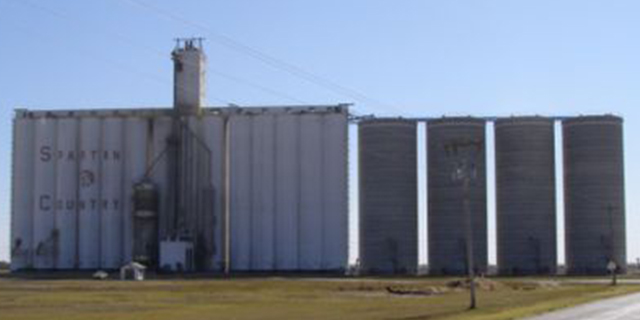Deerfield Elevator
206 W. 6th St.
Deerfield, Kansas 67838
620-290-2647 (Cell) Grains handled: Wheat, Milo, Corn, Soybeans
Hours
7:30 AM – 5:00PM
Services
- Grain
Grains Handled
Wheat, Milo, Corn, Soybeans
DEERFIELD HISTORY
The addition of Co-op facilities and services at Deerfield brought the elevator total up to seven on June 1st, 1963. At that time, the service station properties of W.E. Bechtel, and the Kelley Grain Company elevator became a part of Garden City Co-op through purchase. For some time, the Deerfield community members had felt the lack of adequate service station services and urged the Board of Directors to extend Garden City Co-op facilities and services to Deerfield. Mr. Bechtel asserted his willingness to sell his properties since he is engaged in other activities and needed more fishing time too.
A grain elevator is an integral part of a complete farm marketing and farm supply service. Mr. Eugene Kelley, former Garden City Co-op Manager, was approached and asked if he would sell his Kelley Grain Company elevator. He agreed, so the properties were purchased. The wooden frame elevator held approximately 32,000 bushels and was purchased for $45,000.
According to the Kearny County Historical books, the first elevator was built in 1908. A picture in the book, taken in 1912, shows the name of C.C. Isely Lumber Co. on the structure. In about 1920, the Deerfield farmers formed the Deerfield Co-op Association. There were between 20 to 30 members. They secured a building and operated a grocery store. They also bought the elevator and operated it until 1924 when it was sold to H.H. Everly, who was the manager of the Garden City Co-op. The members didn’t think the elevator was a paying deal, so they sold it to Everly. Everly operated the elevator under the name of Everly Grain Co. for two years. In 1926, he sold it to Thomas L. Daniel and Charles Philpot who changed the name to the Deerfield Elevator Co. A year and a half later, Daniel bought Philpot’s interest and became the sole owner. The structure contained 8 bins, was 30 feet high and had a storage capacity of about 6,000 bushels. They had a blower to load the grain onto the rail cars. In the head house, they were able to change from bin to bin with a hand crank. According to Daniel, a complete feedmill was located to the north of the elevator where they ground, mixed and sold feed under the Deerfield Elevator Co. name. The coal sheds were located to the west of the elevator.
In 1929 or 1930, the elder Daniel built the first elevator on the Garden City Western Railway at Wolf. At the time, it was known as one of the most efficient elevators ever built in this part of the country. It was 50 foot tall and didn’t require a blower to load the grain. Daniel went broke in 1931 and sold everything to Southwestern Grain Co., which he used to own a part of. A couple of years later, Daniel bought back the elevator at Deerfield disposing of the feedmill and ran it as a straight country elevator. The elder Daniel reached retirement in 1945 and sold the elevator to E. E. Kelley who had been managing the Garen City Co-op Elevator. But Kelley decided he needed a larger elevator, so in 1949, the old one was torn down. Kelley was then told that the footing (soil condition) was not sufficient to build as large an elevator as he had planned, so he settled for a 32,000 bushel “cribbed elevator”. The wooden bins were formed by laying 2x4’s side by side on the lower part, 2x6’s on the upper part. The entire structure was covered with metal siding. The new elevator was 55 to 60 foot tall, had 9 bins, and a leg (a conveying system to move the grain to the top of the elevator so that it could be dropped into the bins). The office building was built in 1952. Kelley owned and operated the elevator until 1963, when he sold it to the Garden City Co-op.
In 1977, the Garden City Co-op constructed a new 1,077,000 bushel concrete elevator. Special precautions were taken to insure a good footing. It has two 10,000 bushel legs, a dryer and two dumps. The office houses a general store and a warehouse.
In 1991, the old frame elevator was removed.


Area Grain Manager - Joe Varela - Cell: (620) 290-0401
